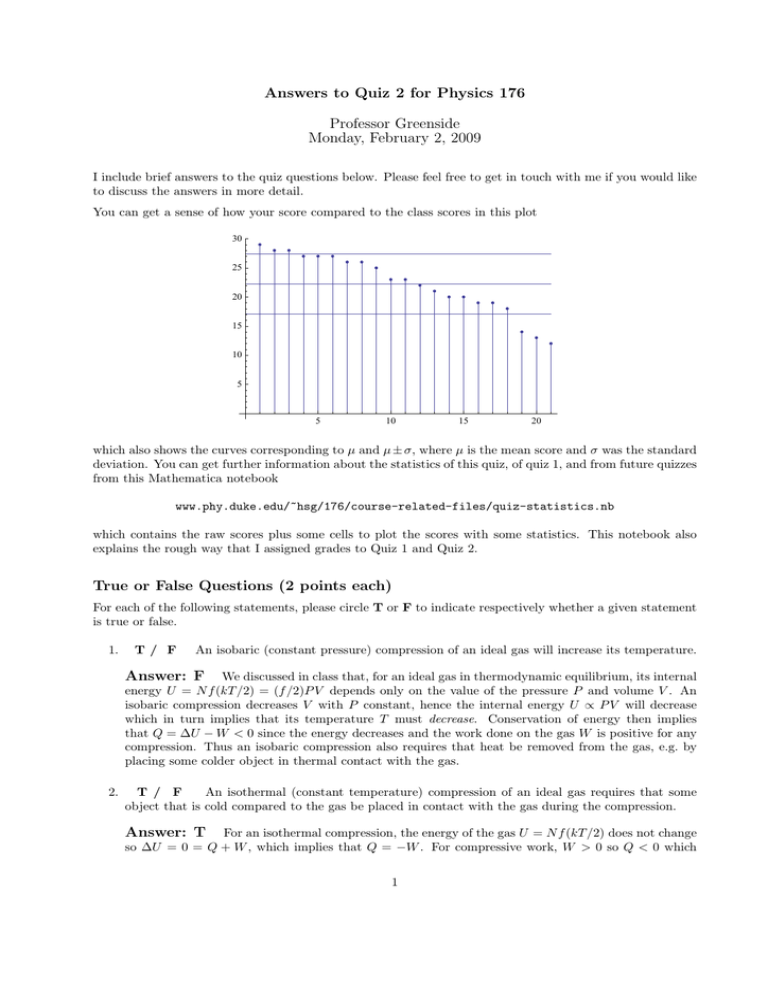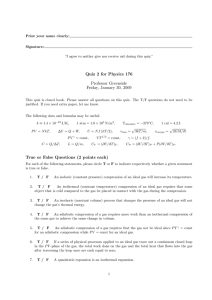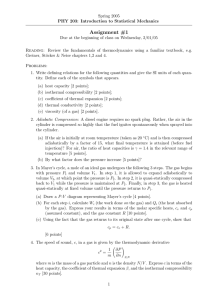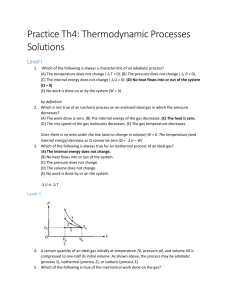Answers to Quiz 2 for Physics 176 Professor Greenside
advertisement

Answers to Quiz 2 for Physics 176 Professor Greenside Monday, February 2, 2009 I include brief answers to the quiz questions below. Please feel free to get in touch with me if you would like to discuss the answers in more detail. You can get a sense of how your score compared to the class scores in this plot 30 25 20 15 10 5 5 10 15 20 which also shows the curves corresponding to µ and µ ± σ, where µ is the mean score and σ was the standard deviation. You can get further information about the statistics of this quiz, of quiz 1, and from future quizzes from this Mathematica notebook www.phy.duke.edu/~hsg/176/course-related-files/quiz-statistics.nb which contains the raw scores plus some cells to plot the scores with some statistics. This notebook also explains the rough way that I assigned grades to Quiz 1 and Quiz 2. True or False Questions (2 points each) For each of the following statements, please circle T or F to indicate respectively whether a given statement is true or false. 1. T/ F An isobaric (constant pressure) compression of an ideal gas will increase its temperature. Answer: F We discussed in class that, for an ideal gas in thermodynamic equilibrium, its internal energy U = N f (kT /2) = (f /2)P V depends only on the value of the pressure P and volume V . An isobaric compression decreases V with P constant, hence the internal energy U ∝ P V will decrease which in turn implies that its temperature T must decrease. Conservation of energy then implies that Q = ∆U − W < 0 since the energy decreases and the work done on the gas W is positive for any compression. Thus an isobaric compression also requires that heat be removed from the gas, e.g. by placing some colder object in thermal contact with the gas. 2. T / F An isothermal (constant temperature) compression of an ideal gas requires that some object that is cold compared to the gas be placed in contact with the gas during the compression. Answer: T For an isothermal compression, the energy of the gas U = N f (kT /2) does not change so ∆U = 0 = Q + W , which implies that Q = −W . For compressive work, W > 0 so Q < 0 which 1 means that heat must flow out of the gas during an isothermal compression. This requires thermal contact with some colder object. 3. T / F An isochoric (constant volume) process that changes the pressure of an ideal gas will not change the gas’s thermal energy. Answer: F An isochoric process corresponds to moving vertically, up or down, in the P V -plane of an ideal gas. Because U ∝ P V , any change in the value of P V will change the internal energy of the gas. Here we are told that V is constant and P changes so the thermal energy must change, although we don’t know the sign of the change unless we are told that the pressure increases or decreases. 4. T / F An adiabatic compression of a gas requires more work than an isothermal compression of the same gas to achieve the same change in volume. Answer: T This follows directly from Fig. 1.12 on page 25 of Schroeder and from discussions in class. Adiabatic compression increases the temperature of a gas, which means that the P (V ) curve traced out by the compression must cross from one isothermal hyperbola P V = N kT to another isothermal hyperbola at higher T , i.e. the P (V ) curve for an adiabatic process lies above any isothermal process that both start at the same point in the P V -plane. Since the work done by compression is the area under the P (V ) curve, this implies that adiabatic compression requires more work. One could also show this mathematically by looking at the integral Z Z Vf W =− Vf P (V ) dV = − Vi CV −γ dV, (1) Vi where γ = (f + 2)/2 > 1 and C is determined by the values Pi , Vi of the common starting point in the P V -plane of the compression (These data let us evaluate the constant C for which P V γ = C). But if γ > 1, the function V −γ increases more rapidly than V −1 as V decreases, which leads to the same conclusion as above. 5. T / F An adiabatic compression of a gas requires that the gas not be ideal since P V γ = const for an adiabatic compression while P V = const for an ideal gas. Answer: F It is somewhat confusing that two similar expressions appear in the discussion of gases, P V = constant for an ideal gas and P V γ = constant for an adiabatic change in a gas. But both expressions are fully compatible with a gas being ideal, and this is a classic example of how it is not sufficient to memorize a formula, you need to remember the context in which the formula was derived or discussed. The first equation is really P V = N kT which means that P V is constant only if the number N of particles and the gas’s temperature T are both constant as P or V are varied. But the assumption of constant temperature T does not hold for an adiabatic compression so it is not a contradiction that P V γ = constant in that case. If you read Schroeder carefully, you might have noticed that he in fact used the ideal gas law P V = N kT to go from Eq. (1.39) to Eq. (1.40) on page 26. 6. T / F If a series of physical processes applied to an ideal gas trace out a continuous closed loop in the P V -plane of the gas, the total work done on the gas and the total heat that flows into the gas after traversing the loop once are each equal to zero. Answer: F No thinking should have been needed for this question since we worked out an example in class, and you worked out an example in the most recent homework, in which one traces out a simply connected closed loop in the P V -plane and the total work done on a gas and the total heat added to the gas are both nonzero. However, their sum Q + W = 0 is always zero for an ideal gas (and not necessarily zero for a non-ideal gas) since U ∝ P V means that the thermal energy of a gas 2 always returns to its original value after tracing out an arbitrarily complicated and criss-crossing loop in the P V plane to return to the same starting values of P and V . 7. T/ F A quasistatic expansion is an isothermal expansion. Answer: F A quasistatic expansion is one that is sufficiently slow mechanically that the gas is always in mechanical equilibrium so that one can talk meaningfully about the pressure P of the gas. An isothermal expansion is necessarily quasistatic since, as we have seen several times in recent lectures, the relaxation time for heat, L2 /κ, is much longer than the relaxation time for mechanical equilibrium, L/vs where vs is the speed of sound in the medium; it takes so long to let the temperature equilibrate after each little adjustment of the system, there is plenty of time to reach mechanical equilibrium. (And this implies that one does not want to use isothermal processes in heat engines or refrigerators, such processes take too long.) An adiabatic compression would be an example of a quasistatic expansion that is not isothermal: it is easy to expand a gas quickly enough for mechanical equilibrium to be achieved at each step without thermal equilibrium occurring. 8. T / F If a person were placed in a small room with plenty of food, water, and air such that the walls of the room were essentially perfect thermal insulators, that person’s body temperature would eventually increase to a fatal level. Answer: T Humans steadily generate energy through chemical reactions, and like any process that converts energy from one form to another (e.g., our bodies create and degrade other chemicals like proteins and DNA, move muscles, extract waste products from blood to produce urine, etc, which all require some source of energy), the process is not perfectly efficient (for reasons we will discuss in this course, related to entropy production). So some of the energy generated ends up in increased kinetic motion of molecules which corresponds to increasing the temperature of the body. As long as a person continues to metabolize food, there is energy production and the thermal energy of the body will increase. Humans limit the rise of their body temperature in two ways: they bring themselves into contact with cooler sources like surrounding air (e.g., you can change from a long-sleeve shirt to a short-sleeve shirt to increase the contact of your skin with cooler air) and they sweat, which eliminates internal energy by converting water to water vapor. But in a room that is thermally isolated as in this problem, two things will happen: the temperature of the room will continue to rise as the person’s body continues to increase its internal energy and the water vapor will reach a saturating concentration in the air which means that the person can no longer shed thermal energy by evaporation of sweat. The person’s body and the air in the room will continue to increase in temperature until the person dies, which happens around 106◦ F ≈ 41.1◦ C when the brain starts to die. You have probably read about (but I hope not experienced first-hand) heat stroke, e.g. when marathon runners race on a particularly warm day. Heat stroke is caused precisely by the inability of the body to keep its temperature within a viable range and is exacerbated by heavy exercise (lots of energy generated to warm the body) and when the surrounding air is hot and humid so that the body can’t eliminate some of its thermal energy. Architects worry a lot about the energy generated by human bodies, especially when in large numbers and in relatively small rooms. They need to make sure enough air flows through such rooms that the excess body heat can be carried off. 9. T/ F The heat capacity CV of 2 moles of ammonia gas, NH3 , is less than the heat capacity of a gaseous mixture consisting of one mole of N2 and three moles of H2 . (Note: all gases are ideal and the temperature is so high that no degrees of freedom are frozen out.) Answer: F Assuming all gases are ideal, the heat capacity CV = dU/dT of 2 moles of ammonia gas would be (2NA )fammon (k/2) where NA is Avogadro’s number. Ammonia is a non-linear molecule (it 3 looks like a nitrogen ball on three hydrogen legs) with K = 4 atoms so fammon = 3 + 3 + 2(3K − 6) = 18 since there are three translational degrees of freedom for the center of mass, three rotational degrees of freedom for the center of mass, and 3K − (3 + 3) = 6 vibrational degrees of freedom that contribute 2(kT /2) each to the thermal energy. So here CV = 36NA (k/2). The total thermal energy U of one mole of N2 and three moles of H2 would be Utotal = NA fN (kT /2) + (3NA )fH (kT /2) = NA (7/2 + 3(7/2))(kT /2) = 14NA (kT /2) which implies that CV = (dU/dT )V = 14NA (k/2). (I have used here the fact that, for ideal gases, the internal energies are additive since the particles don’t interact with each other.) We see that CV (ammonia)/CV (mixture) = 36/14 ≈ 2.6 so the ammonia gas has a substantially larger heat capacity. This is rather interesting because both gases have the exact same number of atoms; the heat capacity clearly depends through the factor f on how the atoms are attached to one another. 10. T/ F It is possible for an object to have a solid angle Ω of 12. Answer: T The solid angle Ω = A/R2 is a dimensionless number (no physical units) that is defined to be the ratio of the area A of some region on the surface of a sphere of radius R to the quantity R2 . Since the maximum surface area is 4πR2 on such a sphere, Ω is a number between 0 and 4π ≈ 12.4 so it is just possible for an object to have Ω = 12 but not, say, a value of 13. An object with Ω = 12 would cover nearly the entire surface of a sphere and could not be seen in its entirety with human eyes (since we can’t see behind our heads). 11. T / F If the radius of a planet were somehow to double with all other properties unchanged (its mass, the temperature of its exosphere), then atomic hydrogen will escape more rapidly from that planet’s atmosphere. Answer: T This problem followed directly from our discussion in class about how molecules of mass m p in a planet’s exosphere of temperature T will be lost over geological times if the thermal speed v = 3kT /m > 0.2vescape where vescape is the escape speed for that planet. (Note: except for gas giants like Jupiter and Saturn, the atmospheres of planets are so thin compared to the radii of the planet (Earth’s atmosphere spans 50 km, versus a radius of 6,400 km) that we can assume that vescape is the same everywhere through the atmosphere.) Increasing the radius of a planet decreases p √ the escape speed as 1/ R, so the condition v = 3kT /m > 0.2vescape becomes satisfied to a greater extent. Something to Calculate Microscopic analysis of an iron meteorite found in Antarctica showed that it completely liquefied upon entering the atmosphere. 1. (3 points) Was the iron meteorite melted by heat or by work? (Justify your answer briefly.) Answer: by work. Heat might have played a tiny role when the meteorite first entered the atmosphere since the denser parts of the atmosphere are hotter than -125◦ C. But there are no parts of the atmosphere that come close in temperature to the melting point of Fe so the overwhelmingly part of the temperature increase must have come from friction between the Fe and surrounding air. By our definitions, this is work not heat. In fact, as the temperature of the meteorite approaches and then reaches the high melting point of Fe, heat goes the wrong way, with the meteorite losing heat to the surrounding cooler air. 4 2. (5 points) If the temperature of the meteorite before entering the atmosphere was -125◦ C, estimate to one significant digit the minimum speed v of the meteorite when it entered the Earth’s atmosphere. Some thermodynamic data for iron: the melting point is 1808◦ C, the specific latent heat of fusion is 2.9 × 105 J/kg, the boiling point is 3023◦ C, the specific latent heat of vaporization is 6.3 × 106 J/kg, and the specific heat is 450 J/(kg · C◦ ). Answer: 2 × 103 m/s . Energy is needed to raise the Fe meteor to its melting point and then to melt all of the Fe. If the mass of the meteor is m, the energy needed is given in terms of the specific heat c = 450 J/(kg · C◦ ) and the specific latent heat L = 2.9 × 105 J/kg of fusion. (I realize you might not have seen the phrase ”heat of fusion” before, but you could deduce this to be the right quantity since no vaporization occurs here, i.e., turning liquid Fe into Fe vapor.) The thermal energy needed is then m (c∆T + L) , (2) where the temperature difference ∆T = 1808 − (−125) ≈ 2000 + 100 = 2100 ≈ 2000◦ C to one digit. Where does this energy come from? From the context of this problem, of a meteorite arriving from space with some initial but unknown speed v, a reasonable guess is that the kinetic energy (1/2)mv 2 is the source of energy that melts the meteorite. The minimum speed v occurs if all the kinetic energy of the meteorite goes into melting the meteorite. As you might guess, some of the kinetic energy will also go into heating the air that the meteorite comes in contact with and into other processes like fluid turbulence of the air, sound, and light. So the actual initial speed is likely much higher than our estimate here. Equating the kinetic energy to the total thermal energy above, we see that the mass m of the meteorite divides out and we find: v = (2(c∆T + L))1/2 ¡ ¡ ¢¢1/2 ≈ 2 450 × 2000 + 3 × 105 ¡ ¡ ¢¢1/2 ≈ 2 12 × 105 √ √ ≈ 2.4 × 106 ≈ 2 × 103 m/s. (3) (4) (5) (6) (7) to one significant digit. An answer of 1 × 103 was also acceptable depending on how you rounded, e.g. rounding the 12 to 10. A few comments based on various answers provided by students: (a) Several students used up precious time multiplying out numbers with lots of digits. The trick for estimating numerical expressions quickly and easily is to round all of your data to one significant digit before you do any arithmetic, since only one significant digit was requested in the final answer. Provided one rounds enough numbers up or down during the process, the rounding errors will approximately cancel and leave a useful answer. √ (b) When one takes square roots of some power of ten, a × 10b , take or add a factor of ten away from the power 10b so that the power becomes an even number and the prefactor √ a becomes a number 24 × 105√should be between 1 √ and 10, whose√square root is√easily estimated to one digit. Thus √ 3 6 5 be written as 2.4 × 104 = 2.4×102 . written as 2.4 × 10 = 2.4×10 and 0.24 × 10 should √ Then √ use simple mental estimates to approximate α for some number α between 1 and 100. Thus 2.4 must be a number between 1 (whose square is 1) and 2 (whose square is 4). If√you remember your squares, that 152 = 225 and 162 = 256, then 1.52 = 2.25 and 1.62 = 2.56 so 2.4 is closer to 2 than 1 and rounds to 2. A similar trick holds for other powers. For example (26 × 107 )1/5 could be estimated by adding or subtracting powers of ten from 107 until one has an integer exponent that is divisible by 5,1 and by arranging the prefactor to be some number larger than one whose 5th-root can be estimated. ¡ ¢1/5 I would write this as 2600 × 105 = 26001/5 × 10. Now 105 = 100, 000 and 55 = (10/2)5 = 5 105 /25 = 100, 000/32 ≈ 100, 000/30 ≈ 3, 000 so a quick guess is 26001/5 ≈ 5 to one digit. The actual value is 4.8 to two digits. (c) Does a speed of about 2 km/s make sense scientifically? If you recall from lecture, we discussed that the escape speed for Earth is about 11 km/s so, perhaps surprisingly, the meteor’s estimated speed is substantially less than the escape speed. I don’t know the typical speeds with which meteorites strike the Earth’s atmosphere, but they could actually exceed the escape speed because the Earth is rotating around the Sun and a meteorite could strike the Earth from the “front”, for which the relative speed is largest. Gravitational interactions of rocks with planets (especially Jupiter) can also boost or decrease speeds substantially, so it is hard to tell whether 2 km/s is reasonable or not, although it is almost certainly too small. p (d) A few students used the formula v = 3kT /m as the speed for the meteorite, incorrectly connecting this problem to a gas in thermodynamic equilibrium. The fact that the meteorite was arriving from space with some initial speed suggests that its speed is not related to some equilibrium process. And the meteor does not stay around in the atmosphere long enough to equilibrate with the air molecules, it falls to the ground rapidly. Perhaps ironically, one can get the right answer for the wrong reasons using this formula because one can say that (1/2)mv 2 = (3/2)kT for the meteorite and then equate the thermal energy (3/2)kT to the energy m(c∆T + L) needed to melt the iron. This leads to the correct relation and the correct answer. (e) A few students guessed that it was the gravitational energy mgh, released from the fall of the meteorite to the ground, that provided the energy that melted the meteorite. This guess doesn’t allow one to bring in the initial speed v into the problem but does raise an interesting issue, of whether the initial kinetic energy is larger or smaller than the gravitational energy released by falling to the ground. Assuming an atmosphere of h = 50 km in thickness, the energy released by falling to the Earth would be mgh which we want to compare to (1/2)mv 2 . Dividing out by the mass m, we can easily compare (1/2)v 2 ≈ 2 × 106 , with gh ≈ 10 × (5 × 104 ) so the kinetic energy is greater than the potential energy released by a factor of about 4, which suggests that gravity could be playing a role although not a dominant one. 6







